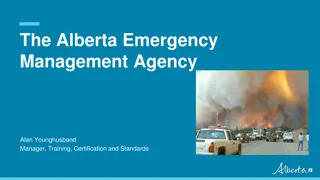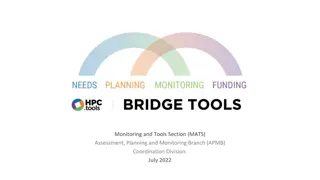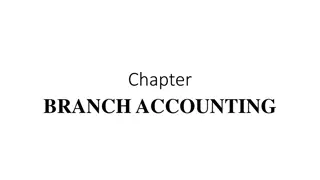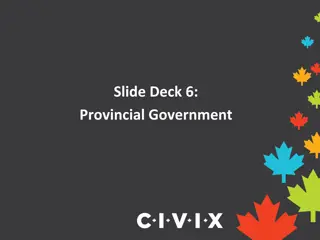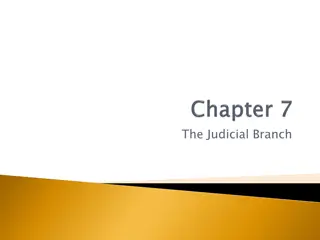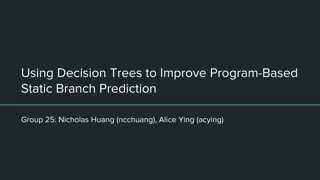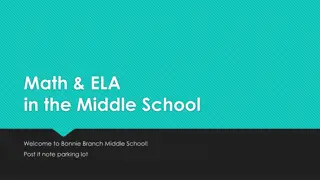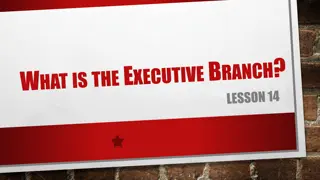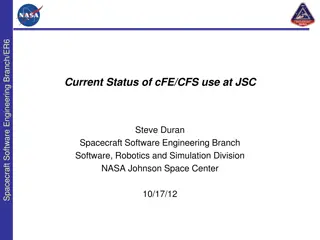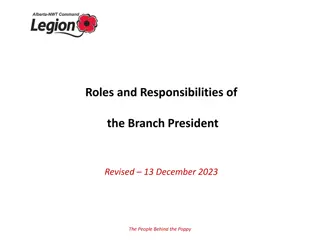
Sea Cadet Program Management: Branch and RCSCC Collaboration Guide
Learn about the collaborative working relationship between the Branch President and the RCSCC Commanding Officer to support and deliver the Sea Cadet program effectively. Essential guidelines for successful collaboration and cooperation are outlined, emphasizing the importance of communication, compliance with policies, and mutual respect.
Download Presentation

Please find below an Image/Link to download the presentation.
The content on the website is provided AS IS for your information and personal use only. It may not be sold, licensed, or shared on other websites without obtaining consent from the author. If you encounter any issues during the download, it is possible that the publisher has removed the file from their server.
You are allowed to download the files provided on this website for personal or commercial use, subject to the condition that they are used lawfully. All files are the property of their respective owners.
The content on the website is provided AS IS for your information and personal use only. It may not be sold, licensed, or shared on other websites without obtaining consent from the author.
E N D
Presentation Transcript
Notes, comments and Questions Notes, comments and Questions Note that the current NL65 document on the National and ON Division website requires some editing and updating to reflect new policies and procedures for topics like Fundraising and Screening as well as the most recent MOU between the DND/CAF and League partners RCSU representatives are joining us and will assist with comments and responses to questions from a DND/CAF perspective You may use the chat to post questions or use the raise hand function Please introduce yourself as you pose your question If we don t have time for all of your questions, please send them by e mail and we will follow up with all participants to provide a response
NL(65)E Branch-Sea Cadet Relationship Guide Aim: to describe the working relationship between the Branch President and the RCSCC Commanding Officer. The Branch President and the RCSCC Commanding Officer make up the local Management Team to support and deliver the Sea Cadet program in the local community. They need to work in a collaborative and positive manner in order to achieve the aims and objectives of the program as defined by the Navy League of Canada and DND/CAF.
Navy League Canadian Forces (CAF) KEY National President CJCR Formation Branch President and Commanding Officer are responsive to each other and must communicate in an open and collaborative manner Executive Committee Division President RCSU National Board Branch President Corps CO Branch Committee Corps Staff
Collaboration and Cooperation Between Branch and CO/RCSCC Staff Absolutely essential to the success of any Corps! Branch must comply with Bylaws, policies and procedures issued by the Navy League of Canada and Ontario Division CO/Corps Staff required to comply with Department of National Defence (DND) and Canadian Armed Forces (CAF) regulations, policies and procedures and CJCR Formation direction through Regional Cadet Support Unit (Central). Both entities must respect each others roles and responsibilities as well as their own chains of command. Best approach to collaboration and cooperation involves constant and open dialogue and consultation to address issues regarding support to the Corps and ensure both the Branch and Corps are kept well informed and engaged
Roles Branch: - Represent the Navy League and the cadet movement in the local community. - Provide support and arrange local facilities for the Corps (with input from the CO) -Comply with NLC By Laws, Policies and Procedures and the MOU between the Leagues and DND/CAF -Participate actively in the Consultative Framework meetings and Governance Bodies CO/RCSCC Staff: - Comply with regulations and orders from DND/CAF - Ensure staff/cadets informed/acquainted with regulations and orders - Responsible for development of staff - Direct and supervise all duties of personnel under their control - Appoint cadets to cadet roles and duties - With consultation of the Branch recommend enrolment, appointment, promotion, transfer or release of staff - Any other duties assigned by CO/RCSU, Area O/C or other lawful CAF authority
Shared Responsibilities between the Branch and RCSCC Finances (Budget and Financial Management) Public Relations (promoting the program) Community engagement Official Hosting Opportunities Administration Supply Instruction (Program support of optional activities for cadets) Note: all responsibilities are assigned as part of the Terms of Reference for the Branch President and CO but may be delegated as required.
Fundraising Branch Commanding Officer Provide assistance to Branch by encouraging staff and cadets to assist and participate in activity Organize and conduct fundraising activities and events Make necessary presentations to sponsors and benefactors Welcome donors and respond to questions Submit receipts for donations for tax purposes Submit all fund raising monies to the Branch for accounting and safekeeping Thanks and invite donors to cadet events Assist in hosting donors at cadet activities
Budget Branch Commanding Officer Prepare an annual budget that acts as a cost estimate for the activities and operations planned for the training year including LSA Review annual budget submission from the CO and consult with CO on LSA plans and submissions Submit budget for approval by Executive Assist the Branch plan and execute a strategy to cover anticipated costs Determine strategy to cover anticipated costs Work with the Branch to review and revise the budget as requirements change Work with the CO to complete LSA clams in a timely manner Support activities and expenditures forecast in the Corps budget and assist with purchases and payments Work with the Branch to complete LSA claims in a timely manner and follow up on payment of claims
Financial Management Branch responsibilities Responsible for financial commitment to the Corps and the Branch Account for funds, ensure expenditures are relevant to the program and direct support of cadet activities If authorized by Branch, the CO may be provided with a small petty cash fund for day-to-day minor expenses and would be responsible to seek approval prior to expenditures as well as timely submission of receipts and supporting documentation Ensure that only specified Branch member(s) handle funds collected through fundraising, donations, membership dues, canteen sales, etc. and that all funds are properly accounted for and deposited into Branch bank accounts Take necessary steps required for negotiation and payment of goods and services Regularly inform Commanding officers with financial statements of Corps related funds and status of budget Complete annual Inventory review and ensure equipment belonging to Branch is accounted for and documented Be available to address financial requirements as they arise and provide reports to Division
Financial Management Commanding Officer Notify Branch of necessary expenditures made against the approved budget Provide Branch with claims or receipts for the Corps expenditures If Petty Cash authorized, expenses must be pre-approved and receipts must be forwarded to the Branch in a timely manner Ensure that all funds raised or collected are submitted to the Branch. Ensure that LSA plan is prepared early in the training year and that all eligible receipts for LSA claims are submitted to DND in a timely manner Prepare estimates or quotes of expected cost for the purchase of specific goods and provide to the Branch Regularly inform the Branch on the status of approved budget items/activities and expenditures Ensure all inventory held by the Corps on behalf of the Branch is accounted for and inventories presented to the Branch each September and prior to any Change of Command Be available to address requirements as they arise and adjust the budget accordingly
Local Support Allocation (LSA) These funds are allotted through DND/CAF to each Corps to mitigate financial and fundraising pressure on local Branches and may be used to purchase a wide range of items to support Corps (name will change to Corps/Sqn Support Allocation) Each year, every Corps is allocated a certain amount of funding according to the strength of the Corps and CO receives a letter with this information from RCSU Be proactive and plan early Branch President should coordinate with the RCSCC CO and try to spend the allocated amount before the end of March. Additional funds may be available if you have a plan and make a timely request. The claim submission process includes a signed statement of concurrence from the Branch President on the CF 52 Form completed and signed by the CO. Once claims are reviewed by the RCSU for compliance and if all is in order, approved reimbursements will be paid and deposited into the Branch account for the Corps by electronic funds transfer.
Local Support Allocation (LSA) An e mail was sent to Branches 4 Dec from the Division with attachments showing allocations, instructions and a list of how these funds may be used While the deadline for submissions of plans was set at 15 Dec 21, Corps may still submit plans and claims up to the end of March. However, earlier is better to ensure approval and potential to qualify for additional funding as remaining funds are reallocated in the last quarter of the FY Further information is available on the Central Region SharePoint site at Financial Services section https://collaboration.cadets.gc.ca/Sites/cen/Shared Documents/03 - J8 Financial Services. Questions regarding use of LSA may be directed to Michael.Nixon@forces.gc.ca
Potential eligible LSA expenses Rent or permit/user fees for trg, admin and/or supply space, Storage locker rental, Utilities (electricity, gas, water/sewage, telephone, etc., but not property taxes, TV or internet) Postage and mailing General office supplies (check first what is available to order through Supply system) Office furniture Video Display Unit(s) for classroom(s) (Portable or fixed projector and screen or LED Display) Supplemental training equipment not available through system, or in additional numbers where justified and scale is limited (sports stores, field stores, nautical / expedition / aviation stores and supplies, orienteering / marksmanship / biathlon supplies Consumable training supplies (para cord, rope, glow sticks, naphtha/propane, flip charts/paper, markers, boot polish/cloths, etc ) Expenses in support of approved optional training (bus/vehicle rental, meal, entrance/registration fees) Registration fees for optional activities including virtual events (Duke of Ed, Army run, Navy Bike Ride, museums and tours, etc.) Band supplies and equipment (instruments and accessories, lyres, music / scores, mace, DM sash, etc.) Approved optional uniform parts and modifications not provided through the system (highland dress items, approved affiliated unit dress items, cap tally, balmorals, glengarries, lanyards, nametags, etc) Flag party equipment (poles, frogs / baldricks, RCACC/RCACS banner, leather gauntlets / cotton gloves, etc.) Cadet Corps Mess Dinner (must be a proper Mess Dinner conducted IAW the applicable QSP EO, and not a dining in or Christmas Dinner). Only cc/sqn staff and cadets may be covered.
Questions Lets take a moment and review what we have covered so far. We will answer any questions at this time
Recruiting Branch Commanding Officer Coordinate information campaign for recruiting of cadets, officers and staff with the CO Assist the President in developing the recruiting campaign Advertise the program Support the campaign ensuring cadet support Seek and use publicity materials Provide recruiting material Involve the parents, provide an info session with the CO to outline the program and the importance of volunteers Welcome parents and cadets with info session on the program
Promoting the Program Public Affairs/Community Engagement Branch Commanding Officer Provide the Branch with information on training or activities for release to the media Represent the Branch and Corps in public Communicate various events of importance to the media Support the Branch by organizing the cadets for public appearances and activities Organize Corps participation in public events Liaise with Regional Public Affairs officer as appropriate Solicit parents to volunteer for events and activities Direct parents to Branch to volunteer related with their expertise/competency Utilize parents and volunteers to assist in advertising Corps activities
Administration Branch Commanding Officer Oversee administration of the corps Oversee Administration of the Branch Reply to and communicate relevant information as soon as received Advise CO of any correspondence received affecting cadets or administration of the Corps Make available and encourage use of all CAF and NLC publications, policies and guidelines Make available and encourage use of Navy League and CAF publications, policies and guidelines Send nominal rolls of cadets and staff to Branch by 30 Sep (see note below on sharing of info) Maintain Nominal Rolls and conduct screening/re- screening of volunteers (Note that screening is now in transition to be a Corps CO responsibility) Waiver on forms signed by parent/guardian allows for sharing of information with the Branch/League) Work with Branch to ensure all Corps staff and volunteers are properly screened (new CAF policy transition)
Hosting Branch Commanding Officer Establish and foster relationships with key dignitaries and local community leaders Support Branch to foster good relationships with local community by attending meetings and facilitating access to the Corps by invitation Invite local leaders and dignitaries to special ceremonies or events, welcome them, present them to Corps staff Highlight their presence as appropriate Ensure invited dignitaries are welcomed and receive the due respect Work closely with Branch to promote these opportunities and assist with drafting letters of appreciation Promote opportunities to recognize and thank benefactors Represent the Corps by attending meetings and other activities in the community and RCSU. Be available at the meetings held by the Branch, community partners and RCSU, in uniform as required.
Instruction/Program Support Branch Commanding Officer Ensure program offered is meeting the goals of the Navy League of Canada and the CAF and is beneficial and interesting to the cadets. Discuss the annual training plan with the Commanding Officer to determine budget and support requirements. Develop and present the annual training program to the Branch in accordance with the established standards and explain goals and vision, including budget requirements as applicable Consult with the cadets, corps staff and the Branch for preferences for optional and core program activities to be held in the future In agreement with the Commanding Officer, assist in organizing other activities not included in the mandatory program and provide volunteer support and assistance as required.
Conflict Resolution Lowest level of resolution always recommended talk to each other! Process emphasizes responsibility of participants to reach resolutions concerning their situations within their areas of responsibility If issues cannot be resolved consult with and elevate through respective organizations but do not blindside your partners provide information at the earliest stage possible and be transparent! Both parties expected to make every effort to act in spirit of cooperation to resolve issues and come to a solution Start with informal, amiable process, this often leads to a resolution
Conflict Resolution Informal Process: Need to identify underlying causes of conflict Resolution must be flexible and effective Allows for those involved to create their own durable solutions Will foster the continuation of good working relationships
Conflict Resolution Always start with lowest level as possible and begin with an Informal Process: Need to identify and work to resolve the underlying causes of conflict Resolution must be flexible and effective Allows for those involved to create their own durable solutions that will foster the continuation or restoral of good working relationships If unable to resolve informally at the local level or concerns are with the President and/or CO, elevate through respective chains of command but do not blindside your partners be transparent! Both parties expected to make every effort to act in spirit of cooperation to resolve issues and come to a solution Always respect privacy and maintain confidentiality and do not involve or engage cadets
Conflict Resolution If informal process is not successful - first consult with the Division and/or Area O/C then move to Formal Process Either Branch President or RCSCC may refer the issue to mediation by contacting the Division or RCSU chain of command Only use when multiple attempts at informal process are unsuccessful, Branch President and CO will meet with a designated mediator, both parties will outline issue as they see it. At this level of conflict resolution, most conflicts can still be resolved simply by involved parties working with a mediator by: Listening to all sides of the conflict and ensuring confidentiality and fairness Organizing the facts and analyzing them Listing several solutions and trying to identify what changes would help resolve the problem When a resolution has been reached with the assistance of the mediator, the results and recommendations must be documented and a solution process developed for implementation with measures to monitor progress and evaluate and/or measure success or desired outcome.by the appropriate chain of command
Cadet Awards and Promotions Cadet Awards and Promotions Branch roles and responsibilities Branch roles and responsibilities Ensure that the Commanding officer is aware of all selection criteria and deadlines for Navy League Awards. Attend the award selection board with the CO and attend award ceremonies Ensure that all members of the Branch address any comments regarding Corps personnel or cadets to the Branch President, so that it can be communicated to the Commanding Officer
Cadet Awards and Promotions Cadet Awards and Promotions Commanding Officer s roles and responsibilities Commanding Officer s roles and responsibilities Make sure the cadets and staff under their AOR are being recognized under both the Navy League and DND/CAF programs Invite a Branch member to attend the selection of awards candidates and Promotion Boards (Coxswain) Evaluate each candidate and assign promotion necessary in consultation with staff Communicate the names of cadets promoted to the Branch
Partnership and Collaboration are key! Communicate and meet regularly Establish the training schedule early so that you can facilitate the budget and fundraising planning Keep everyone informed Consult and communicate with the ON Div Area reps, Zone Trg O and Area O/Cs Work to resolve challenges early at the local level and seek assistance from the Division Share good news stories locally and with the Division and RCSU
Reference: NL(65)E Branch-Sea Cadet Relationship Guide (requires updating to reflect new screening and fundraising policies) It can be downloaded to your phone or tablet, so it is always accessible to you Key Takeaways Both the Branch President and the Commanding Officer have distinct roles and responsibilities as defined by their chains of command. However, there are also many areas for collaboration and cooperation as community partners that are essential to the support and delivery of the cadet program. Together, with consistent engagement and open communication, you can provide an amazing program to your local youth, that aligns and complies with Navy League of Canada and Canadian Armed Forces guidelines and program pillars Thanks very much for all that you are doing in your communities to deliver and support the Sea Cadet Program!
Questions? Questions? You may use the chat to post questions or use the raise hand function Please introduce yourself as you pose your question If we don t have time for all of your questions, please send them by e mail and we will follow up with all participants to provide a response The presentation will be posted on the Ontario Division website with either a transcript or recording of the training session


